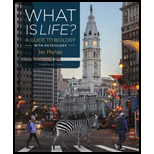
To analyze:
The two challenges facing plants as a consequence of their lack of mobility.
Introduction:
Plants are mainly multicellular predominantly photosynthetic eukaryotes of the kingdom Plantae. Plants do not show locomotion; instead they show tropic movements in response to sunlight, gravity etc.
Explanation of Solution
Plants face two challenges due to their lack of mobility. Plants have diploid and haploid life stages. The haploid stages allow the plants to reproduce sexually by the fusion of male and female gametes (fertilization). Getting sperms to eggs for fertilization can be one of the challenges for many plants living on land, especially if the plants are large or live in dry conditions. Some plants enlist the help of animals to carry the male gamete to the female gamete. As a result of their inability to move, another challenge which plants face is that they cannot run from or escape from predators. Plants develop other means of defense, including thorns and poisonous chemicals.
There are the two challenges which face by the plants due to their inability to move:
- Getting sperms to eggs for fertilization.
- Plants cannot run from or escape from predators.
Want to see more full solutions like this?
Chapter 14 Solutions
What Is Life? A Guide to Biology with Physiology
- To explain the increase in mass of the light-grown plants, identify one inorganic source of new plant mass and connect it to the cellular process underlying the increase in mass.arrow_forwardDescribe two roles where ABA shows to be rather ecological and physiological significance to the plant.arrow_forwardWhen plants first moved on to land, they faced with a wide variety of new challenges. Two of these challenges include the risk of drying out and the ability to access/transport resources. Describe not just list 4 adaptations that allow plants to cope with these challenges, 2 for coping with drying out and 2 for coping with accessing/transporting resources.arrow_forward
- Describe a modified structure and function of the following plant organs: Leaf - Stem - Root -arrow_forwardPlants are classified into three types based on water availability in its habitat. What are these types? Cite at least one leaf adaptation (morphological/ anatomical) on each type.arrow_forwardPlants provide a wide range of benefits to both the ecosystems in which they live, as well as to humans. Identify and describe 1) a benefit to the ecosystem, and 2) a benefit to humans specifically (1-2 sentence per function). Be sure to include information regarding why these functions are important or what impact they have.arrow_forward
- Stomata are pores on the surface of plant leaves that allow for gaseous exchange. The numbers below shows the density of stomata on the leaf surfaces of three species of plants. Based on this information, which statement is incorrect? Stomata Density: Elodea (upper epidermis) = 0, (lower epidermis) = 0, Water Lily (upper) = 420, (lower) = 0, Black Walnut (upper) = 0, (lower) = 465 a) Since Elodea does not have any stomata, it does not carry out photosynthesis. b) In Elodea’s aquatic environment, stomata are not used to control gas exchange. c) Since black walnut trees thrive on land, stomata are located on lower surface to decrease the amount of water lost in the heat of the sun. d) Since water lilies live on the surface of water, transpiration occurs from the upper epidermis because that is where it is in contact with air.arrow_forwardBy choosing any 2 of the following topics/systems, discuss how does the animal and plant (name the animal and plant) works in maintaining their function in an environmental stress (name the stress) mentioned above. a) Transport System b) Digestive System c) Respiratory System d) Excretory Systemarrow_forwardDiscuss the effect of environmental conditions on the Maturation and Ripening Stage of sugar canearrow_forward
- Explain four changes that occur as vegetative grass changes to reproduction phasearrow_forwardWhich of the following is NOT a function of the stem in a plant? Which of the following is NOT a function of the stem in a plant? A) absorb water B) store nutrients C) produce new plant cells D) support flowers and leavesarrow_forwardGive examples of different types of leaves and theirfunctions.arrow_forward
